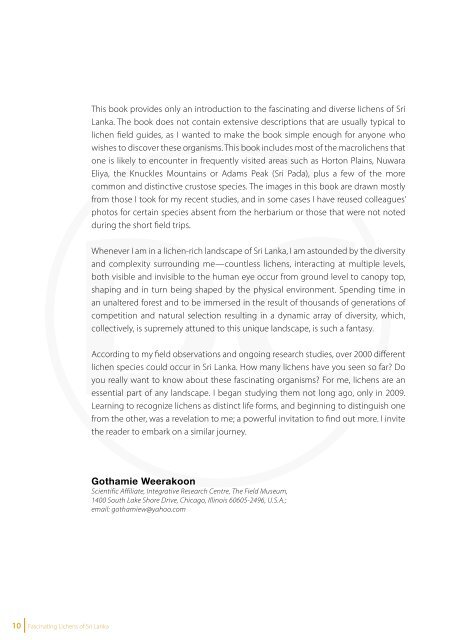Fascinating Lichens of Sri Lanka
Fascinating Lichens of Sri Lanka
Fascinating Lichens of Sri Lanka
- No tags were found...
You also want an ePaper? Increase the reach of your titles
YUMPU automatically turns print PDFs into web optimized ePapers that Google loves.
Acknowledgements<br />
This book provides only an introduction to the fascinating and diverse lichens <strong>of</strong> <strong>Sri</strong><br />
<strong>Lanka</strong>. The book does not contain extensive descriptions that are usually typical to<br />
lichen field guides, as I wanted to make the book simple enough for anyone who<br />
wishes to discover these organisms. This book includes most <strong>of</strong> the macrolichens that<br />
one is likely to encounter in frequently visited areas such as Horton Plains, Nuwara<br />
Eliya, the Knuckles Mountains or Adams Peak (<strong>Sri</strong> Pada), plus a few <strong>of</strong> the more<br />
common and distinctive crustose species. The images in this book are drawn mostly<br />
from those I took for my recent studies, and in some cases I have reused colleagues’<br />
photos for certain species absent from the herbarium or those that were not noted<br />
during the short field trips.<br />
Whenever I am in a lichen-rich landscape <strong>of</strong> <strong>Sri</strong> <strong>Lanka</strong>, I am astounded by the diversity<br />
and complexity surrounding me—countless lichens, interacting at multiple levels,<br />
both visible and invisible to the human eye occur from ground level to canopy top,<br />
shaping and in turn being shaped by the physical environment. Spending time in<br />
an unaltered forest and to be immersed in the result <strong>of</strong> thousands <strong>of</strong> generations <strong>of</strong><br />
competition and natural selection resulting in a dynamic array <strong>of</strong> diversity, which,<br />
collectively, is supremely attuned to this unique landscape, is such a fantasy.<br />
According to my field observations and ongoing research studies, over 2000 different<br />
lichen species could occur in <strong>Sri</strong> <strong>Lanka</strong>. How many lichens have you seen so far? Do<br />
you really want to know about these fascinating organisms? For me, lichens are an<br />
essential part <strong>of</strong> any landscape. I began studying them not long ago, only in 2009.<br />
Learning to recognize lichens as distinct life forms, and beginning to distinguish one<br />
from the other, was a revelation to me; a powerful invitation to find out more. I invite<br />
the reader to embark on a similar journey.<br />
Gothamie Weerakoon<br />
Scientific Affiliate, Integrative Research Centre, The Field Museum,<br />
1400 South Lake Shore Drive, Chicago, Illinois 60605-2496, U.S.A.;<br />
email: gothamiew@yahoo.com<br />
I am especially grateful to Dilmah Conservation for funding the publication <strong>of</strong> this<br />
lichen book for <strong>Sri</strong> <strong>Lanka</strong>.<br />
This book was made possible by the kindness and encouragement from many<br />
people: fellow researchers, administrators, amateur enthusiasts and colleagues<br />
who contributed their expertise and assistance. Many lichenological colleagues<br />
contributed specimens, photographs, and helped with the identification <strong>of</strong><br />
specimens. Special mention must be made <strong>of</strong> the following for their support:<br />
Thorsten Lumbsch, Robert Lucking, Pat Wolseley, Andre Aptroot, Susan Will-Wolf,<br />
Felix Schumn, Yoshihito Ohmura, Dan Blanchon, Sittiporn Parnmen, Matthew Nelson,<br />
Philippe Clerc, Holger Thues, Cecile Gueidan, Steve Leavitt, Ekaphan Kraichak, Eimy<br />
Rivas Plata, Bruce McCune, Pier Luigi Nimis, and Colman Patrick Cloonan.<br />
I am especially thankful to my senior supervisor, Thorsten Lumbsch, for his mentoring<br />
and encouragement which made this book possible. I wish to thank Pat Wolseley for<br />
inspiring my love for lichens. Further, I also wish to express my gratitude to Robert<br />
Lucking, and Andre Aptroot, whose pr<strong>of</strong>ound knowledge <strong>of</strong> tropical lichens and<br />
guidance is absolutely central to my involvement with lichens.<br />
I wish to acknowledge the University <strong>of</strong> <strong>Sri</strong> Jayewardenepura, National Science<br />
Foundation-USA, Field Museum-USA, Natural History Museum-UK, National<br />
Geographic Society, British Lichen Society and Dilmah Conservation for their<br />
generous support for my research. Heartfelt thanks also to Peter Raven, President<br />
Emeritus <strong>of</strong> the Missouri Botanical Garden.<br />
Thanks to Chandrani Wijeyaratne for her valuable life lessons.<br />
And thanks to Siril Wijesundara, Veranja Karunaratne, Udeni Jayalal, Aruna<br />
Weerasooriya, Ranil Rajapakshe, and Dinzardhe Raheem for their support.<br />
Finally, I am very grateful for my husband, my two sons, my family, friends, and all<br />
those who made this book possible.<br />
10 <strong>Fascinating</strong> <strong>Lichens</strong> <strong>of</strong> <strong>Sri</strong> <strong>Lanka</strong><br />
<strong>Fascinating</strong> <strong>Lichens</strong> <strong>of</strong> <strong>Sri</strong> <strong>Lanka</strong> 11
















